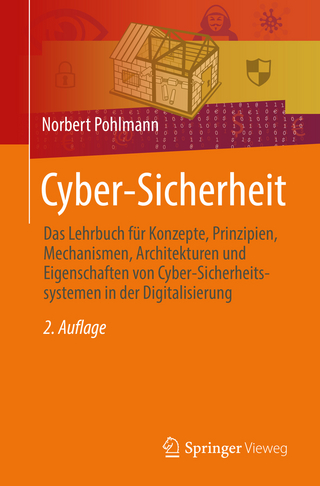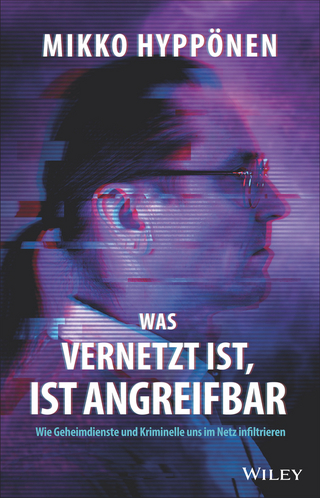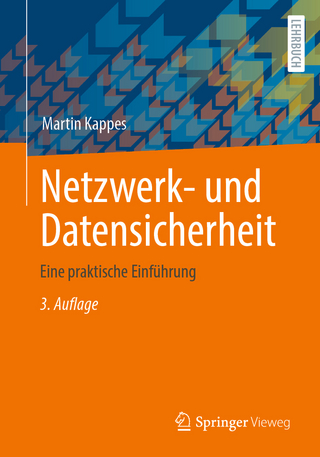
Artificial Intelligence For Security
Springer International Publishing (Verlag)
978-3-031-57451-1 (ISBN)
- Noch nicht erschienen - erscheint am 07.08.2024
- Versandkostenfrei innerhalb Deutschlands
- Auch auf Rechnung
- Verfügbarkeit in der Filiale vor Ort prüfen
- Artikel merken
This book discusses the use of artificial intelligence (AI) for security purposes. It is divided into three parts: methodological fundamentals of AI, use of AI for critical infrastructure protection and anomaly detection. The first section describes the latest knowledge for creating safe AIs and using them to enhance protection. This book also presents various domains and examples of AI-driven security. The chapters describe potential methods, demonstrate use cases and discuss the challenges of the evolving field. This includes topics such as defensive use of AI to detect threats. It discusses the offensive use of AI to better understand the future threat landscape, the use of AI for automation in critical infrastructure and overall challenges of AI usage for critical tasks.
As new threats emerge, the use of AI technologies to protect the world one lives in is topical. New technologies in this space have advanced rapidly, and subsequently, their use in enhancing protection is an evident development. To this effect, this book brings together a group of international researchers and professionals who present their views on how to create security through AI.
This book targets postgraduate students, researchers and professionals who want to understand the use of AI for security. Understanding latest advancements in this field will also be useful to those who want to comprehend modern cybersecurity in detail and who want to follow research and latest trends.
Tuomo Sipola works as a senior researcher at the Institute of Information Technology at Jamk University of Applied Sciences, Jyväskylä, Finland. His research interests include machine learning and data analytics, and he has worked in both research and commercial projects in many application areas, including predictive maintenance, network security and medical imaging. This earlier work experience includes research positions at the University of Jyväskylä and CEO duties in his startup company, CAP Data Technologies. He received the Ph.D. degree in mathematical information technology from University of Jyväskylä, Finland, in 2013, the M.Sc. degree in information technology from the same university in 2009, and, recently, the M.A. degree in Latin from the same university in 2020.
Janne Alatalo received the Master of Engineering degree in information technology from Jamk University of Applied Sciences in 2023, and the Bachelor of Engineering degree in the same field in 2014 from the same school. Janne Alatalo is working as a Specialist at Jamk University of Applied Sciences. His research topics include applied Artificial Intelligence and Cybersecurity. The working background includes multiple R&D projects at Jamk University of Applied Sciences where he has applied his software engineering, data-analytics, and artificial intelligence skills to many real-world problems. His current research interests include artificial intelligence, data-analytics, and cybersecurity.
Monika Wolfmayr is a senior researcher in applied mathematics. After finishing her Ph.D. in Engineering Sciences at the Johannes Kepler University Linz, Austria, two years of postdoctoral research at the Johann Radon Institute in Linz, and five years as postdoctoral researcher at the University of Jyväskylä, Finland, she has worked since April 2022 as senior researcher at the Jamk University of Applied Sciences in Jyväskylä. Her research focus are efficient computational methods, optimization, reliable error estimation, and noise reduction methods in hyperspectral image processing. She has studied various applications including heat transfer, electromagnetics, waves equation, and recently hyperspectral asteroid imaging as member of the image processing research team of ESA's (European Space Agency) Hera mission and NASA's DART research investigation team member.
Tero Kokkonen works as the director of Institute of Information Technology at Jamk University of Applied Sciences. He is also the director of the cyber security focused research, development, and training center JYVSECTEC (Jyväskylä Security Technology). Tero is the Adjunct Professor in the Faculty of Information Technology at the University of Jyväskylä. He has significantly conducted research and development activities in the domain of cyber security and artificial intelligence including several international scientific publications. He has been member of programme committee and member of technical committee in the several scientific conferences (IEEE, Springer, and ACM) as well as peer-reviewer of several scientific journals. Before his academic career, he has served as a program manager and technical specialist with C4ISR Systems in the Finnish Air Force and also worked in the software industry. He is a graduate of University of Jyväskylä (Ph.D. Mathematical Information Technology, Cyber Security).
Part I Methodological Fundamentals of Artificial Intelligence.- Chapter.1.Safeguarding the Future of Artificial Intelligence: An AI Blueprint.- Chapter.2.Cybersecurity and the AI Silver Bullet.-Chapter.3.Artificial Intelligence and Differential Privacy - Review of Protection Estimate Models.- Chapter.4.To Know What You Do Not Know: Challenges for Explainable AI for Security and Threat Intelligence.- Chapter.5.Securing the Future: The Role of Knowledge Discovery Frameworks.- Chapter.6.Who Guards the Guardians? On Robustness of Deep Neural Networks.-Part II Artificial Intelligence for Critical Infrastructure Protection.- Chapter.7.Opportunities and Challenges of Using Artificial Intelligence in Securing Cyber-Physical System.- Chapter.8.Artificial Intelligence Working to Secure Small Enterprises.- Chapter.9.On the Cyber Security of Logistics in the Age of Artificial Intelligence.-Chapter.10.Fuzzy Machine Learning for Smart Grid Instability Detection.- Chapter.11.On Protection of the Next-Generation Mobile Networks against Adversarial Examples.- Chapter.12.Designing and Implementing an Interactive Cloud Platform for Teaching Machine Learning with Medical Data.- Part III Artificial Intelligence for Anomaly Detection.- Chapter.13.Machine Learning and Anomaly Detection for an Automated Monitoring of Log Data.- Chapter.14.Detecting Web Application DAST Attacks in Large-scale Event.-Chapter15.Enhancing IoT Intrusion Detection Using Hybrid DAIDS-RNN Mode.
| Erscheint lt. Verlag | 7.8.2024 |
|---|---|
| Zusatzinfo | X, 338 p. 81 illus., 58 illus. in color. |
| Verlagsort | Cham |
| Sprache | englisch |
| Maße | 155 x 235 mm |
| Themenwelt | Informatik ► Netzwerke ► Sicherheit / Firewall |
| Informatik ► Theorie / Studium ► Künstliche Intelligenz / Robotik | |
| Schlagworte | Adversarial Examples • Applied mathematics • Artificial Intelligence • cybersecurity • ethics • Human AI-workflow • IOT • Machine Learning in Medicine • privacy • Safe AI • Smart Grid • systems and data security |
| ISBN-10 | 3-031-57451-6 / 3031574516 |
| ISBN-13 | 978-3-031-57451-1 / 9783031574511 |
| Zustand | Neuware |
| Haben Sie eine Frage zum Produkt? |
aus dem Bereich


